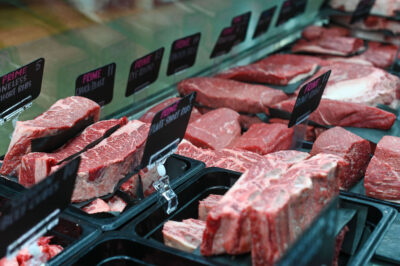Choosing the right cut of beef can make all the difference in your meat’s flavor, texture, and the overall enjoyment of your meal. But with so many different cuts of steak taking up space on the shelves, how do you know which beef cut of meat is right?
If you’ve ever felt overwhelmed by the number of options in the meat aisle and wondered which is the best meat to buy for your recipe, you’re not alone.
We’re breaking down the different cuts of beef, from the 10 primal cuts to the individual portions of steak you can purchase at your local grocery store or meat shop.
Use this guide, compiled by the butchers at our Amish meat stand, to help identify the best cuts of meat to get the most flavor from your recipe.
Where Do Different Cuts of Steak Come From?
When a cow is butchered, it’s usually split into 2 separate cuts: the front quarter and hind quarter. These larger portions are further divided into 10 smaller sections called the primal cuts of beef.
From there, the primal cuts are divided into smaller, sub-primal cuts. Sub-primals are often packaged and sold to grocery stores, restaurants, and other meat vendors because they’re smaller and more manageable than primal cuts, but cheaper than buying individual portioned steaks.
The different retail cuts of steak most of us are familiar with shopping for — New York strip, sirloin, filet mignon, ribeye — are smaller trimmings of the sub-primal cuts.
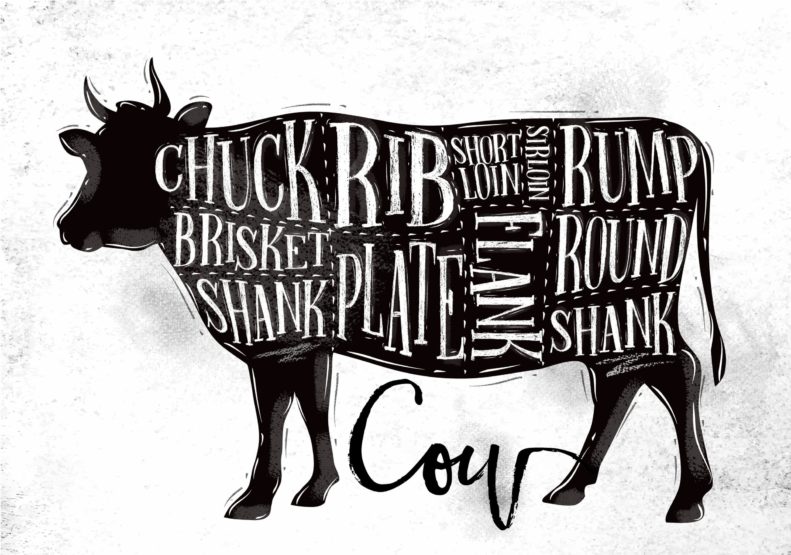
The 10 Primal Cuts of Beef: From Toughest to Most Tender
The first step to becoming an informed steak shopper, aside from understanding how the animal was raised and if it meets your criteria, is to learn the 10 primal cuts of beef. The flavor and tenderness of any steak are a direct result of the primal cut it was sourced from.
Ultimately, certain parts of the cow are tender, while other parts have more muscle and are tougher. Knowing which primal cut of the beef your steak is coming from in relation to the animal’s anatomy helps you make the best decision for your cooking purposes while shopping.
Toughest Primal Cuts
The toughest cuts of steak come from the most muscular parts of the animal: the legs (shank) and the chest (brisket).
1. Shank
Beef shank comes from the animal’s thigh. Considering the leg is a heavily used muscle, this meat is full of connective tissue and is arguably the toughest cut. It comes from the leg, so there are a total of four small primal cuts of beef shank.
As the least popular — and cheapest — cut of meat, beef shank can be hard to find in all retail stores. But if you can find it, don’t discount its ability to shine. These cuts are affordable options for making collagen-rich broths, and they’re the star of the show in the famous Italian dish, Osso buco.
| Ways to Cook (Moist Heat) | Common Dishes |
|---|---|
| Braising Stewing |
Osso buco (braised Italian dish) Beef bourguignon Low-fat ground beef Beef broth pho |
| Sub-Primal Cuts | Popular Portion Cuts |
|---|---|
| Shank cross-cut | Beef shank |
2. Brisket
Beef brisket is taken from the chest area beneath the chuck. It’s a well-worked muscle, so brisket is known for its fatty and tough texture. But when cooked the right way, this primal cut of beef can become one of the most flavorful, succulent cuts.
The secret to achieving melt-in-your-mouth brisket is marinating and cooking low and slow. Marinating the beef before cooking helps soften the muscles, and slow cooking on low heat helps ensure the meat tenderizes and stays juicy.
| Ways to Cook (Moist Heat) | Common Dishes |
|---|---|
| Braising Smoking Slow cooking Roasting Sous vide |
Smoked brisket Pastrami Corned beef Steak sandwiches Barbecue |
| Sub-Primal Cuts | Popular Portion Cuts |
|---|---|
| Brisket flat half Brisket point half |
Brisket |
Moderately Tender Primal Cuts
Cuts of meat from the beef flank, chuck, plate, round, and rump are somewhere in between tough and tender. Certain sub-primal and retail cuts are more tender than others, but all can be delicious when using the right cooking method.
3. Flank
Beef flank is a primal cut taken from beneath the loin and sirloin. It’s taken from the abdomen, so it’s a leaner cut with tough muscle fibers. Generally, beef flank was considered inexpensive, but as the demand for healthier cuts of steak has increased, so has the popularity and price of the flank.
It tastes best when grilled or sautéed over a high heat, but it’s important that it’s not overcooked. It’s a leaner cut of meat, so marinating helps break down some of those fibers before cooking, and cutting against the grain before serving helps shorten those muscle fibers, so it’s less work to enjoy its flavors.
| Ways to Cook | Common Dishes |
|---|---|
| Grilling Pan frying Grounding Braising |
Carne asada Fajitas |
| Sub-Primal Cuts | Popular Portion/Steak Cuts |
|---|---|
| Flank steak | Flank steak Skirt steak |
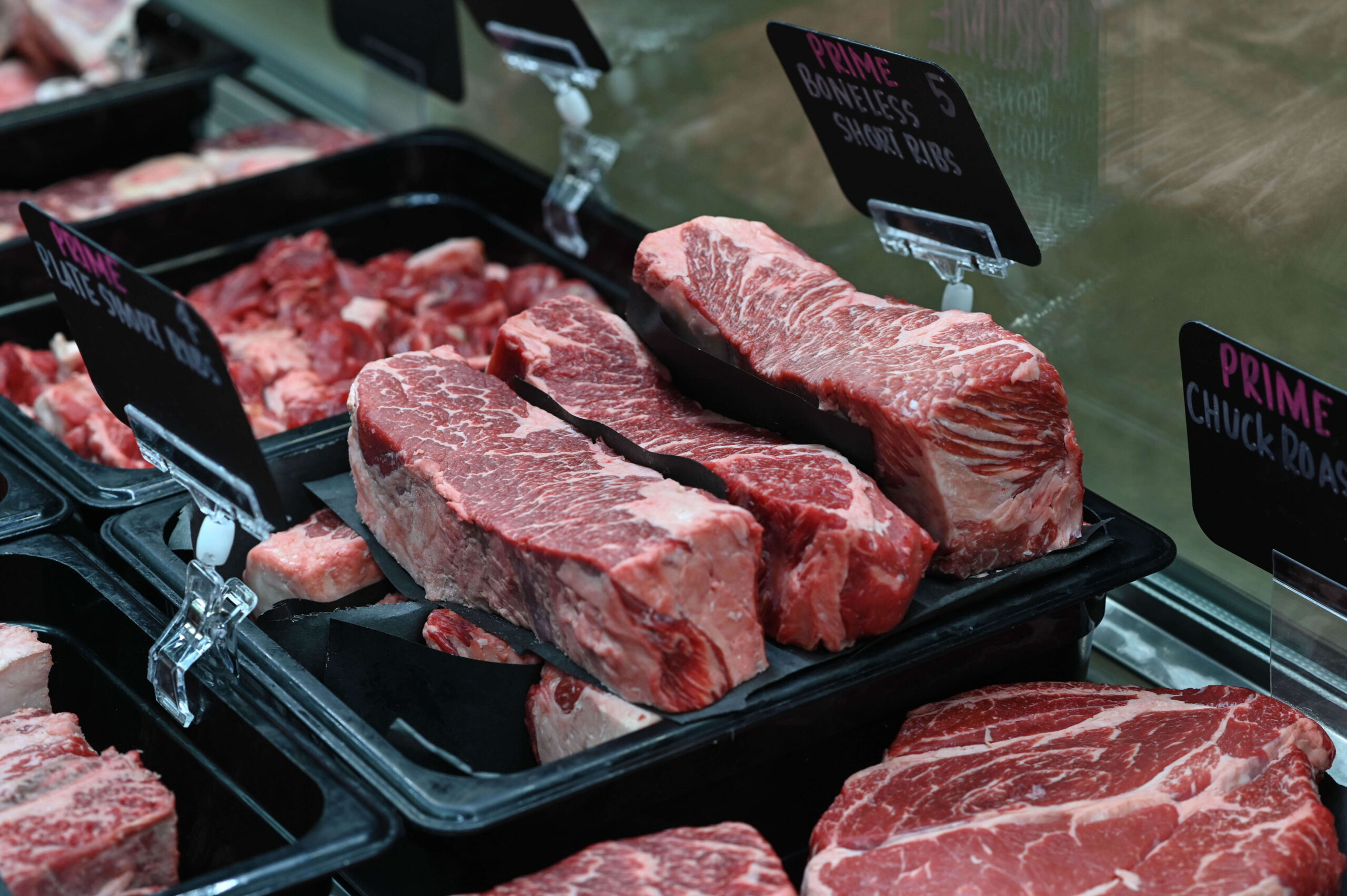
4. Chuck
The chuck cut is taken from the front quarter region of the animal, including meat from the upper arm, shoulder, and part of the neck. These areas contain thick muscle fibers and connective tissue, so the chuck is naturally a tougher cut.
Chuck meat is also high in fat. When cooked low and slow, the fat brings out a rich flavor, and the muscles have time to tenderize to produce a juicy, tender meat. The high fat content also makes beef chuck the most commonly sourced cut for ground beef.
Fun fact: beef chuck usually comes from between the fifth or sixth ribs, so it also has a few inches of the longissimus dorsi muscle — the same one that runs in a tender rib-eye steak!
| Ways to Cook (Moist Heat) | Common Dishes |
|---|---|
| Braising Slow cooking Stewing Grounding |
Pot roasts Burgers Braised short ribs Carne asada |
| Sub-Primal Cuts | Popular Portion/Steak Cuts |
|---|---|
| Chuck tender Chuck roll Should clod Square chuck |
Chuck roast Shoulder roast Shoulder tender medallions Short ribs Ground beef Chuck eye steak Flat iron steak Denver steak Ranch steak |
5. Plate
The beef plate comes from the underbelly of the animal below the ribs. Depending on how it’s separated from the ribs, butchers might refer to this cut as the short plate since it doesn’t include the brisket.
Like some of the other primal cuts of beef we’ve covered, the plate has a high fat content and lots of cartilage, but unlike those same cuts, it’s best cooked quickly over high heat. Just be careful not to overcook it, or it may become too chewy and tough.
Steak from this cut should be marinated before cooking to ensure the most flavor and tenderness.
| Ways to Cook | Common Dishes |
|---|---|
| Stir frying Grilling Grounding Braising (for the short ribs) |
Carne Asada Fajitas |
| Sub-Primal Cuts | Popular Portion/Steak Cuts |
|---|---|
| Short plate Skirt steak Plate short ribs Flanken-style short ribs |
Short ribs Skirt steak Hanger steak Flank steak Ground beef |
6. Round
The round is the largest primal cut of the hindquarter. The meat comes from the animal’s hind legs, so round cuts often contain tendons, ligaments, and muscles that need to be cooked properly to avoid a tough, chewy texture.
Round cuts of beef taste best when prepared using the low and slow method with moist heat. This gives the meat collagen enough time to transform into gelatin, which allows the muscle fibers to soften and separate more easily, tenderizing the meat.
| Ways to Cook | Common Dishes |
|---|---|
| Braising Slow cooking Roasting |
Pot roasts Roast beef |
| Sub-Primal Cuts | Popular Portion/Steak Cuts |
|---|---|
| Bottom round Top round Knuckle |
Rump roast Bottom round roast Round steak Ground beef Eye round roast Sirloin tip Eye round steak Top round steak Bottom round steak |
7. Rump
While some butchers consider the round and rump cuts to be the same, the rump primal cut of beef is taken from the top end of the animal. It contains less muscle and more fat than the round, giving it the reputation as slightly more flavorful and tender.
| Ways to Cook | Common Dishes |
|---|---|
| Braising Slow cooking Roasting |
Pot roasts Roast beef |
| Sub-Primal Cuts | Popular Portion/Steak Cuts |
|---|---|
| Top round | Rump roast Round steak Eye round roast Sirloin tip Top round steak |
Most Tender Primal Cuts
The most tender cuts of beef — and often the best meat for steaks — come from the rib and loin primal cuts. Most of the beef cuts from these locations can be cooked using dry heat.
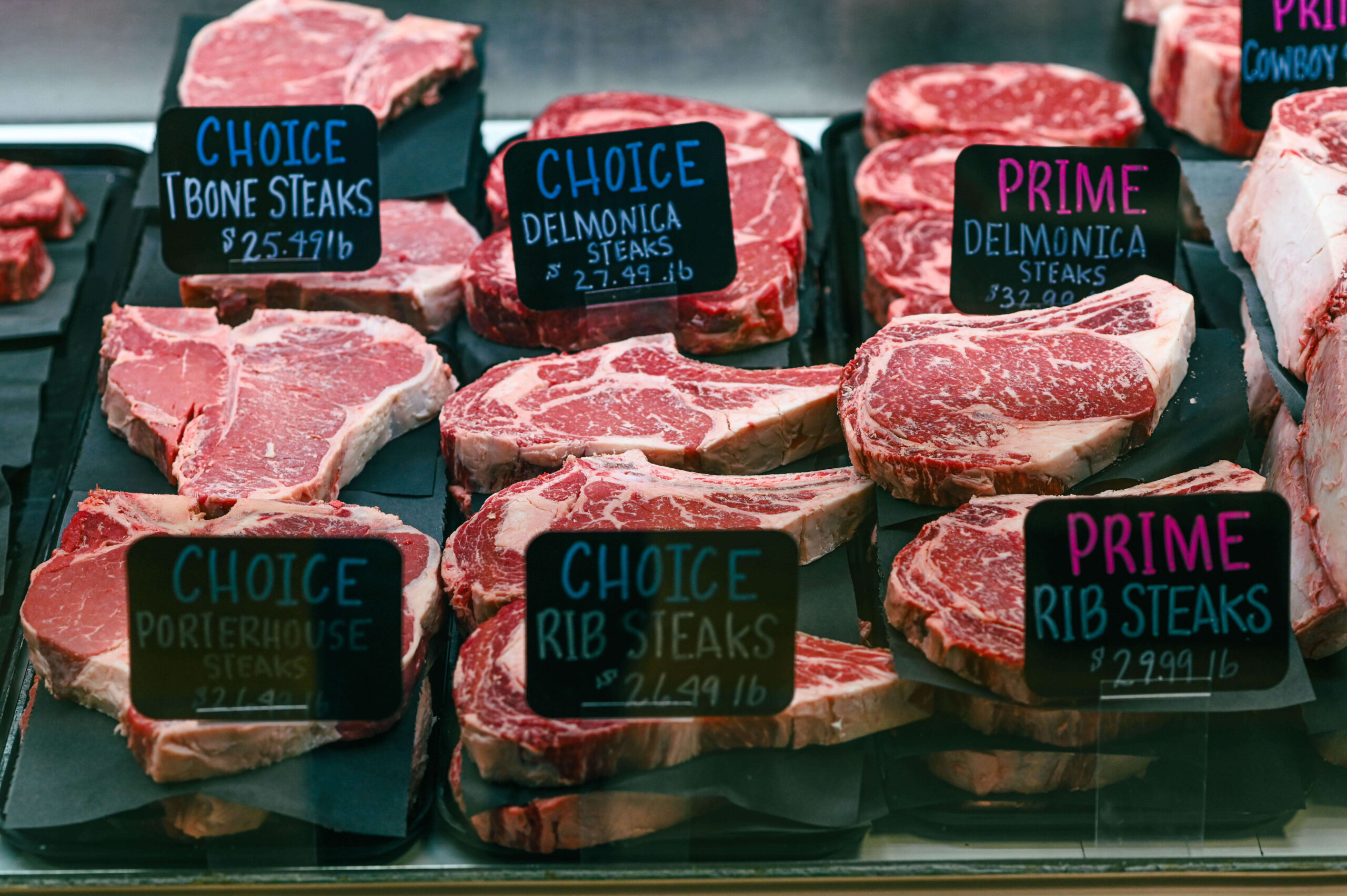
8. Rib
This primal cut is usually taken from between the sixth through twelfth ribs. Coming from the center section of the ribs, this primal cut contains tender meat. This makes it a great primal cut to cook using dry heat.
Cuts from the rib are known for their generous marbling, which infuses the meat with more flavor and tenderness as it cooks.
| Ways to Cook | Common Dishes |
|---|---|
| Grilling Smoking Roasting Braising Broiling |
Prime rib roast Grilled ribeye steak BBQ ribs |
| Sub-Primal Cuts | Popular Portion/Steak Cuts |
|---|---|
| Ribeye roll Rib subprimal 7-bone rib |
Rib roast Ribeye roast Short ribs Back ribs Ribeye filet Cowboy steak Ribeye steak Tomahawk steak |
9. Sirloin
The sirloin and short loin are technically smaller subprimal cuts of the loin, but since they offer some different cuts of steak, we’re going to treat them each as their own primal. The sirloin comes from the rear part of the cow’s hip. It’s less tender than short loin cuts, but still packs the beefy flavor.
The sirloin is further divided into top and bottom cuts. The top is the most tender, so it can be grilled or pan-fried with dry heat, whereas meat from the bottom cut should be slow-cooked or braised.
| Ways to Cook | Common Dishes |
|---|---|
| Grilling Smoking Roasting Braising Broiling |
Filet mignon |
| Sub-Primal Cuts | Popular Portion/Steak Cuts |
|---|---|
| Top sirloin Bottom sirloin |
Tri-tip roast Sirloin steak Tri-tip steak |
10. Short Loin
If you’re looking for top-notch, tender meat, you’ll find it in the short loin cut. Some of the best, most popular steak cuts come from this primal cut. Depending on the thickness, this piece can provide around 11 – 13 different cuts of steaks.
Steak from the loin is usually more expensive, but for good reason. It’s the most tender and versatile cut.
| Ways to Cook | Common Dishes |
|---|---|
| Grilling Smoking Roasting Braising Broiling |
Filet mignon T-Bone Steak Beef Tenderloin |
| Sub-Primal Cuts | Popular Portion/Steak Cuts |
|---|---|
| Tenderloin Strip loin Porterhouse Sirloin Cap |
Filet Mignon Tenderloin roast Tenderloin steak T-bone steak New York strip Porterhouse steak Strip petite roast |
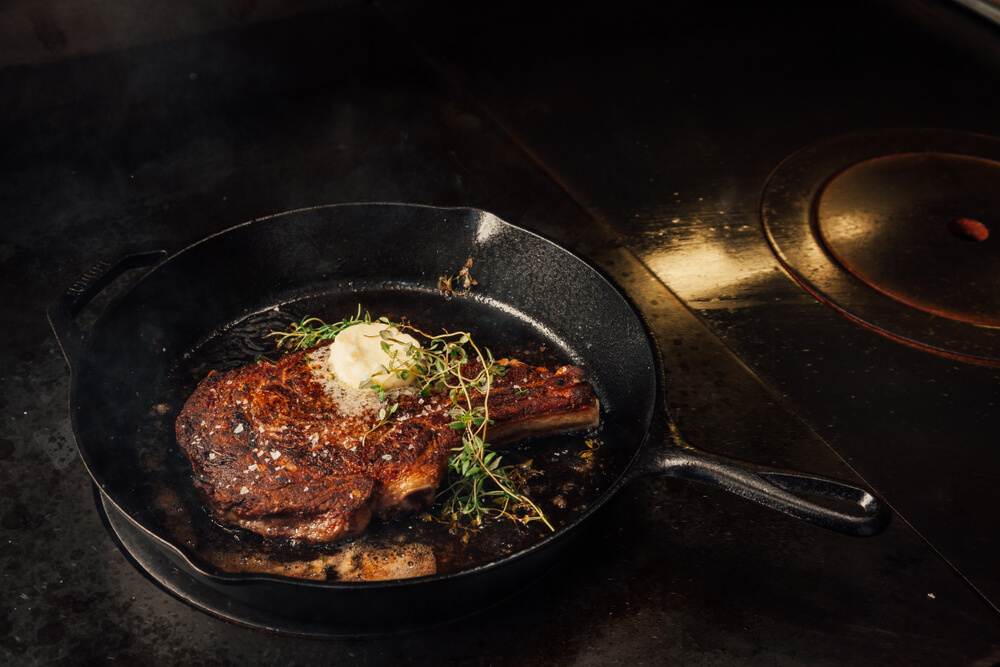
Cooking Tips: Moist Heat vs. Dry Heat
Preparing your beef properly all comes down to one element – heat. There are two types of heat used for cooking beef: moist heat and dry heat. You’ve heard us use these terms quite a few times now, so let’s define them:
- Moist Heat
Moist heat uses water, steam, or liquid as a vehicle to transfer heat to food. It’s a slower cooking process, but it can be great to tenderize tough pieces of meat with a lot of muscle or cartilage.
The low temperature and slow pace can actually help break down the muscle fibers and bring out a rich, beefy flavor of these economical cuts. Some common cooking terms to know associated with moist heat are broiling, steaming, braising, and stewing.
- Dry Heat
Dry heat transfers heat either through the air or by direct contact with a hot skillet. It’s a much faster cooking method for tender meats, which can become tough when cooked for too long.
Some common cooking methods that use dry heat include pan-searing, grilling, frying, baking, and roasting (without liquid).

